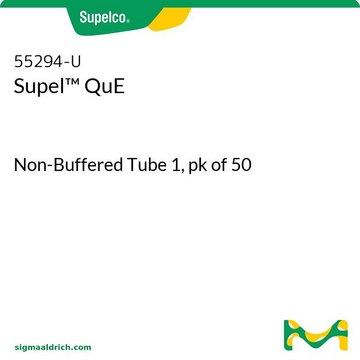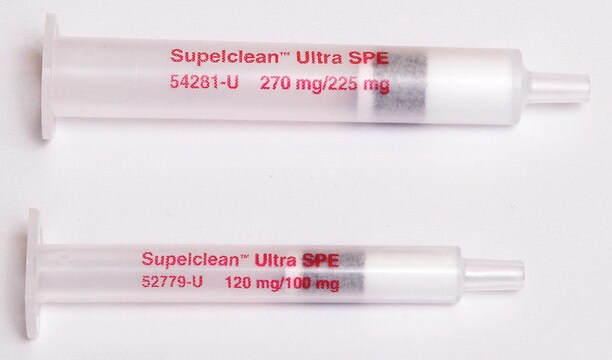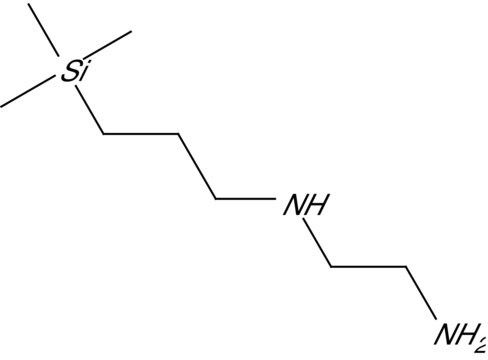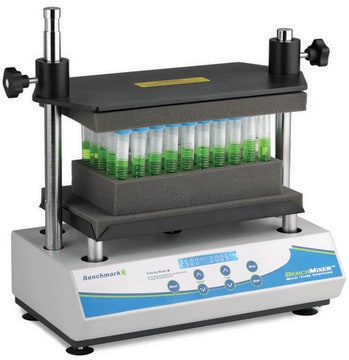55248-U
Supel™ QuE
Empty Centrifuge Tube with Lid, centrifuge tube volume 50 mL, pk of 50, suitable for EN 15662:2008 per BS
Synonym(e):
QuEChERS
About This Item
Empfohlene Produkte
Agentur
AOAC® 2007.01
suitable for BS EN 15662:2008
Zusammensetzung
empty tube (n/a)
Verpackung
pk of 50
Methode(n)
QuEChERS: suitable
Zentrifugenröhrchenvolumen
50 mL
Anwendung(en)
food and beverages
Suchen Sie nach ähnlichen Produkten? Aufrufen Leitfaden zum Produktvergleich
Allgemeine Beschreibung
Mit dem QuEChERS-Verfahren werden die Proben (Nahrungsmittel oder landwirtschaftliche Erzeugnisse) zunächst in Gegenwart von großen Mengen Salzen (z. B. Natriumchlorid und Magnesiumsulfat) und/oder Puffermitteln (z. B. Citrat) mit einem wässrigen, mischbaren Lösungsmittel (z. B. Acetonitril) extrahiert, um die Separation der Flüssigphase zu induzieren und säure- bzw. basenlabile Pestizide zu stabilisieren. Nach Schütteln und Zentrifugierung wird ein Aliquot der organischen Phase einer weiteren Reinigung mittels SPE unterzogen. Anders als bei herkömmlichen Methoden, bei denen SPE-Röhrchen genutzt werden, erfolgt die Reinigung bei der dispersiven SPE durch Mischen von SPE-Großmengen (z. B. Supelclean PSA, ENVI-Carb und/oder Discovery DSC-18) mit dem Extrakt. Nach der Probenreinigung wird die Mischung zentrifugiert; das Ergebnis ist ein Überstand, der entweder direkt analysiert oder vor der Analyse weiterer geringfügiger Behandlung unterzogen werden kann.
Supelco bietet eine Produktlinie von Flaschen und Zentrifugenröhrchen mit vorportionierten Mengen von Salzen und SPE-Sorptionsmitteln, um die aktuell am häufigsten verwendeten Methodenkonfigurationen zu unterstützen.
Anwendung
Rechtliche Hinweise
Anwendung
Probenvorb.
Lagerklassenschlüssel
13 - Non Combustible Solids
WGK
WGK 3
Flammpunkt (°F)
Not applicable
Flammpunkt (°C)
Not applicable
Hier finden Sie alle aktuellen Versionen:
Analysenzertifikate (COA)
It looks like we've run into a problem, but you can still download Certificates of Analysis from our Dokumente section.
Wenn Sie Hilfe benötigen, wenden Sie sich bitte an Kundensupport
Besitzen Sie dieses Produkt bereits?
In der Dokumentenbibliothek finden Sie die Dokumentation zu den Produkten, die Sie kürzlich erworben haben.
Kunden haben sich ebenfalls angesehen
Artikel
The comparison of Supel™ QuE Z-Sep/C18, PSA/C18, and PSA QuEChERS sorbents, in terms of color removal and analyte recovery, is described for the cleanup of oranges prior to pesticide analysis.
Compared to conventional PSA/C18/GCB cleanup, cannabis extracts cleaned with the Supel QuE Verde mixture showed lower GC/MS background, and better recoveries for many pesticides.
Extraction of Permethrin Pesticides from Spinach Using QuEChERS Methodology with Automated Shaking
Glyphosate and related compounds are measured in oatmeal and infant cereal using ion-exchange polymer-based particles for HPLC and SPE. Low level detection was obtained.
Protokolle
A highly selective and sensitive analytical method was developed for chloramphenicol using a QuEChERS type sample preparation approach and LC-MS/MS detection.
Extraction and Analysis of Neonicotinoid Pesticides from Flower Blossoms Using Supel™ QuE and Ascentis® Express
Potency testing in marijuana-infused edibles is an important problem that analytical labs are facing due to the complexity of the involved matrices. Concentration of active ingredients in these edibles can range from a few parts per million to 3.5 parts per thousand. This application demonstrates the extraction and HPLC-UV analysis of the active compounds.
Verwandter Inhalt
Supel QuE Z-Sep+ was successfully demonstrated for cleanup of beef kidney matrix, providing reduced background and less interference in the GC-MS analysis of the target pesticides
Chromatograms
suitable for GC, application for SPEsuitable for GC, application for SPEapplication for HPLCsuitable for GC, application for SPEMehr anzeigenUnser Team von Wissenschaftlern verfügt über Erfahrung in allen Forschungsbereichen einschließlich Life Science, Materialwissenschaften, chemischer Synthese, Chromatographie, Analytik und vielen mehr..
Setzen Sie sich mit dem technischen Dienst in Verbindung.











